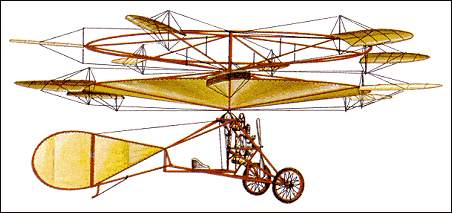Jacob Christian Ellehammer must surely rank among the most versatile of aviation's early pioneers. First apprenticed as a watchmaker, he then qualified as an electrical engineer; he made one of the earliest motor-cycles built in Denmark, and also designed his own internal combustion engines. His 3-cylinder piston engine of 1903 was perhaps the world's first radial engine, and his experiments in aviation, started two years later, embraced monoplanes, biplanes, triplanes, flying boats and helicopters.
Ellehammer's first studies of rotary-winged flight began in 1910, and various experiments were carried out in 1911 with a scale model helicopter. The full-sized machine that he built in the following year would today be defined as a compound helicopter, for its 6hp engine (also designed by Ellehammer) drove both the rotor system and a conventional propeller. The lifting rotors were of an ingenious pattern, consisting of two contra-rotating rings, each of 5.97m diameter, the lower one being covered with fabric to increase the lift. At regular intervals round the perimeter of the wings were six vanes, each about 1.50m long and 0.66m wide and pivoting about its horizontal axis. The rotor system was driven via a hydraulic clutch and gearbox, all designed by Elle-hammer, and the rotor vanes' angle could be altered in flight by the pilot — an early example of cyclic pitch control. After several successful indoor take-off tests, during which the machine was probably tethered, Ellehammer's machine made a free vertical take-off later in 1912, in front of witnesses who included H.R.H. Prince Axel. Tests with the 1912 helicopter continued until late in September 1916, when it overturned after a take-off and the machine was wrecked when the rotors spun into the ground.
Ellehammer then put aside his helicopter experiments until about 1930, when he began to evolve some new projects. One of these was, in effect, a parasol monoplane in whose wings was a huge circular cut-out with two contra-rotating rotors turning inside it. Even more novel was a proposal in the mid-1930s for a helicopter driven by compressed air. As with the previous project, only a working model was built, powered by a vacuum cleaner motor. In the full-sized aircraft Ellehammer proposed to have a radial engine driving a powerful air compressor. A substantial pylon over the fuselage was topped by a metal disc, made to rotate by the reaction from expelling compressed air through slots in its underside. The centrifugal force of the rotating disc was sufficient to unsheath four spring-loaded rotor blades; when take-off had been accomplished, these were retracted back into the disc and the compressed air stream diverted to an efflux at the rear of the aircraft to give it forward movement.
K.Munson "Helicopters And Other Rotorcraft Since 1907", 1968





